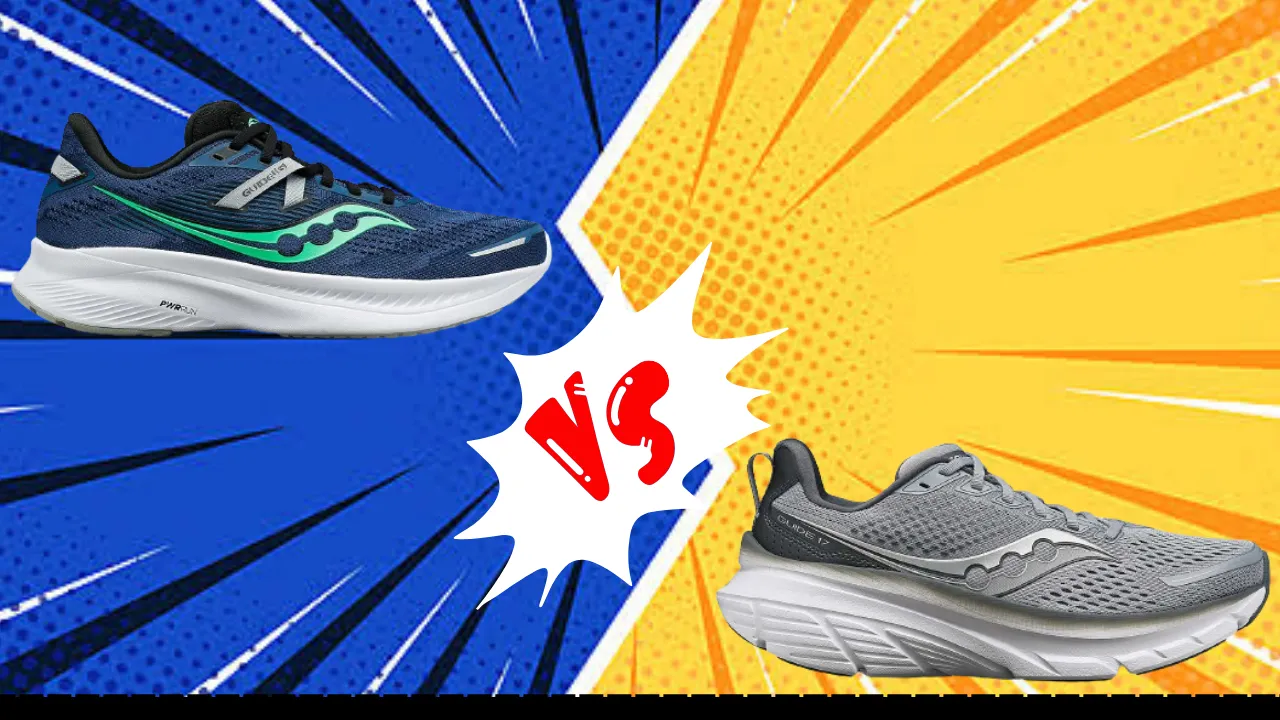If you’re a runner who needs stability and support, you may be trying to decide between the Saucony Guide 16 and the updated Guide 17. The Guide series has long been a favorite daily trainer for overpronators. Both versions offer a balance of comfort, support, and responsiveness.
In this in-depth comparison, we’ll look at the key features and performance of Guide 16 and Guide 17 to help you determine which one is the better choice for your needs. Read on to see how they stack up!
Similarities And Differences Between Saucony Guide 16 And Guide 17:
| Feature | Guide 16 | Guide 17 |
|---|---|---|
| Launched In | 2023 | 2024 |
| Stability | Medial post | Redesigned medial post |
| Flexibility | Moderate | Moderate |
| Sizing | True to size | Runs slightly small |
| Weight | 9.5 oz | 10.6 oz |
| Cushion | PWRRUN | PWRRUN+ |
| Outsole | Rubber | Rubber XT-900 |
| Midsole | PWRRUN | PWRRUN+ |
| Upper | Engineered mesh | Engineered mesh |
| Retail Price | $140 | $140 |
Feature Comparision:
Materials:
The Guide 16 uses a breathable engineered mesh for the upper, which provides a secure and comfortable fit. The midsole is made of PWRRUN, Saucony’s lightweight and responsive foam, while the outsole is rubber.


The Guide 17 also utilizes an engineered mesh upper for breathability and flexibility. The biggest update is in the midsole, which now features the plusher PWRRUN+ foam for a softer feel underfoot. The outsole uses a sticky rubber XT-900 compound for added durability and traction.
Durability:
Testers found that both Guide 16 and Guide 17 are durable shoes that can hold up to daily runs. The Guide 16 may have a slight edge, as some wearers experienced premature wear on the outsole of the Guide 17 after 200 miles. The blown rubber sections on the lateral side tended to show signs of wear first.
However, the XT-900 rubber on Guide 17 does provide an upgrade in traction that contributes to the shoe’s overall durability in varied conditions. Both shoes have an internal heel counter that helps provide structure in the rearfoot.
Fit:
The engineered mesh uppers on Guide 16 and Guide 17 provide a comfortable and precise fit. The Guide 16 runs true to size for most, while the Guide 17 runs slightly smaller than usual.


The midfoot wrap of Guide 17 feels snugger due to its use of an inner sleeve construction in the arch area. The toe box room is comparable in both shoes – wide enough without being sloppy.
Overall, Guide 16 may accommodate more foot shapes, while Guide 17 will work better for those wanting a compressive midfoot fit.
Stability:
Both shoes use a medial post design to prevent overpronation, making them suitable stability trainers. The Guide 16 has a traditional dual-density post that extends from the midsole to provide support.
Guide 17 implements an entirely new approach with the angled GUIDERAILS support framework on the medial side. This provides a smoother transition from heel to toe while still supporting moderate to severe overpronators.
Testers found that Guide 17’s stability features allowed for more natural, fluid foot motion through the gait cycle. The Guide 16 stability will work well for those wanting more rigid pronation control.
Cushioning:
The Guide 16 offers a firm yet responsive cushioning feel from the PWRRUN foam. Riders found it provides adequate shock absorption for most training runs at slower paces.
The company upgraded to its PWRRUN+ foam for the Guide 17, resulting in a much softer ride. The additional cushioning provides more comfort and protection on longer distances and faster efforts.
In terms of shock attenuation and energy return, Guide 17 has a clear advantage with its plush foam. The trade-off is a slightly less stable platform compared to the firmer Guide 16.
Value:
With a $140 retail price, both Guide 16 and Guide 17 deliver excellent value for stability trainers. The upgrades to the midsole and outsole justify the cost of the Guide 17 for runners wanting a more cushioned and lively ride.
Both Guide 16 and 17 remain a budget-friendly option for those focused on getting support and durability without the premium ride quality. Overall, the two models are evenly matched in terms of value depending on runner preferences.
Performance Comparision:
Walking:
The Saucony Guide models provide sufficient cushioning and support for walking, though they are heavier than traditional walking shoes at around 10 ounces.
The Guide 17 will likely feel more comfortable for longer walks thanks to its softer PWRRUN+ foam that better absorbs impact. The ample cushioning in both the heel and forefoot makes them suitable for walking several miles at a time.
They allow natural foot motion and flex during the walking gait cycle. The engineered mesh uppers also provide breathability on warm days. Overall, while not designed specifically for walking, both Guide models perform well for fitness walking, hiking, or all-day wear.
Running:
Ideal for regular road running, Guide 16 and Guide 17 offer a great balance of flexibility, stability, and cushioning for neutral to moderate overpronators. The redesigned midsole foam in Guide 17 gives it a more responsive and energetic feel at faster paces or longer distances compared to the firmer Guide 16.
The additional forefoot flex of Guide 17 also creates a smoother heel-to-toe transition during the running motion. The support provided by the medial posts gives runners the needed structure to prevent inward rolling of the foot. For those seeking a particularly soft and bouncy ride, the Guide 17 is likely the better choice between the two models.
Plantar Fasciitis:
With ample cushioning and arch support from the medial posts, both Guide 16 and Guide 17 can aid runners with plantar fasciitis. However, those with more severe symptoms may benefit more from the extra plushness of Guide 17, which absorbs heel strike impact very effectively to reduce tension on the plantar fascia.
The softer PWRRUN+ foam protects the heel upon landing. The stability features also support proper foot motion to keep strain off the plantar fascia ligament. For mild cases, Guide 16 could still provide enough cushion, but Guide 17 covers both mild and more troublesome plantar fasciitis.
Standing All Day:
The Saucony Guide models provide suitable cushioning for standing all day, though they lack the specialized arch support or cushioning of true work shoes. The ample padding in the heel and forefoot makes them comfortable for extended time on your feet, however.
The Guide 17 may edge out the Guide 16 for prolonged standing since the plusher foam protects against fatigue. The engineered mesh uppers are also breathable to reduce sweating and discomfort when standing for long periods. While neither are ideal work shoes, the Guide 17 in particular can get you through a long day on your feet.
Final Verdict:
Overall, the Saucony Guide 17 is the clear winner as the better daily stability trainer compared to the Guide 16.
The upgrades to the midsole cushioning, stability design, and outsole rubber make the Guide 17 a more comfortable, responsive, and durable option.
The plush PWRRUN+ foam provides a smooth and lively ride that can handle both slow jogs and faster training paces. The newly engineered GUIDERAILS support system also offers great stability that allows for fluid, natural foot motion.
While the Guide 16 is still a quality stability shoe, the Guide 17 outperforms it across the board with its blend of softness, support, durability, and improved ride feel. For overpronators seeking the best in a daily trainer, the Saucony Guide 17 is highly recommended over the 16.

